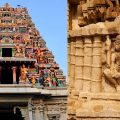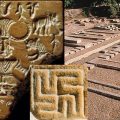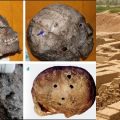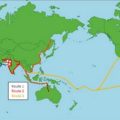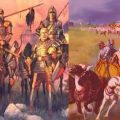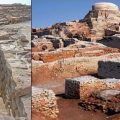Genetic Evidence from Rakhigarhi Reinforces ‘Out of India’ Theory
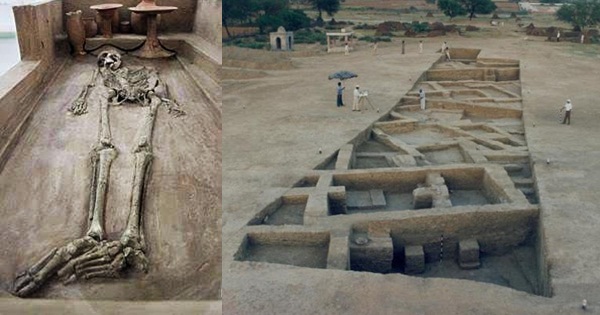
Aryan invasion Theory is a very popular subject in India as every children of India is taught this theory since the last 70 or more years right from the elementary school level. The theory in a nut shell posits that the ancient population of northern India who spoke Samskrtam and authored Vedas, Ithihasa, Purans, Upanishads and other Samskrta literature are not indigenous to India but came from outside of India, primarily from the north western Russian steppes. The Samskrta word ‘Arya’ (denoting a noble person, a prefix denoting honor) was used by these theorists (Angelizing it as ‘Aryans’) to denote the people who thus entered into India from its north and north west. In its different versions, the theory changes the mode of arrival of this population to violent invasion, by killing the then existing native population in battles and wars and displacing the survivors to southern parts of India, to the peaceful migration by dominating the natives culturally and linguistically and thus eliminating them by cultural and linguistic absorption. The displaced, or dominated native population was denoted by another Samskrta word ‘Dravida’ (Anglesizing it as Dravidians).
In reality, the word Dravida denotes a distinct ethnicity of people mostly living close to sea shores, which includes even some sections of Brahmanas like the Pancha Dravidas and in other cases are distinct Kshatriya rulers (the law giver Manu is mentioned as a Dravida in some Puranas) which as per the erroneous Aryan-Dravidian dichotomy of these theorists should belong to the category of Aryans! Dravida also is mentioned as a southern Janapatha (kingdom) distinct from other southern kingdoms like Pandya, Chola and Kerala in certain Aitihasic narratives and in others denote the collective of Pandya, Chola, Keralas, all of them but following Vedic rites for their life events such as the coronation of their kings, which is well attested in both Tamil and Samskrita texts. The entire dichotomy of Aryan-Dravidian is false.
The first version (violent version) is called the Aryan Invasion Theory (AIT) which is now largely discredited, even by its greatest promoters due to utter lack of evidence for an invasion scenario at the said period of its occurrence (around 1500 BCE) and at the said region (North West India) such as the lack of cultural and linguistic discontinuity and remnants of war (weapons, dead bodies etc.).
The second version (peaceful migration) is still argued rigorously despite dwindling evidence. This theory is called the Aryan Migration Theory (AMT). In this situation, certain early results of genetic studies based on the Human Genome Project, by analyzing the DNA and RNA of human population samples across the world came to the rescue of AMT proponents. The genetic samples used for these studies were mostly confined to people living at the present times. If it had to be relevant to the AMT question, the samples from ancient human DNA had to be obtained. This is very rare to find. The genome scientists in collaboration with the archaeologists started getting these samples from rarest of rare living remains of ancient people only recently.
It is too early to make any conclusion based on these genome samples. But the AMT proponents were in a hurry to declare that based on the DNA samples obtained from the Russian steppes and also from North West India ‘proved’ ‘undoubtedly’ that the Aryans came from the Russian steppes to North West India and authored the Vedas.
It is in this context that the new evidence of Professor Vasant Shinde and Niraj Rai has to be evaluated. Professor of Harvard Medical School, David Reich also partnered with Shinde and Rai to study the skeletal DNA from Rakhigarhi. Their study is published in the journal named Cell (referenced at the end of the article). They argue that the DNA study from the skeletal remains excavated from the Harappan cemetery at Rakhigarhi indicates that the hunter gathers of Bharatavarsha (which is often mentioned today in academic circles as ‘South Asia’) have an independent origin. They thus refute the premature conclusion of pro AMT researchers who said Harappans had a Russian Steppe pastoral ancestry or Iranian farmer ancestry. Shinde and Rai also refute the hypothesis of mass migration from outside Bharatavarsha to Sindhu Sarasvati Region (North West India). Shinde said on 6th September 2019 that the team under him has successfully sequenced the first genome of an ancient individual who lived in the Sindhu Sarasvati Region at the time of Harappan settlement. Combining it with the archaeological data in his possession he made the above conclusion refuting the pro AMT arguments based on ancient genome studies. He thus put an end to the last refuge of AMT proponents who until this time was piggy backing on human genome studies to defend their theory.
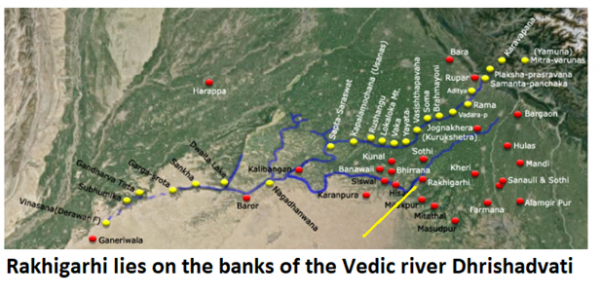
Rakhigarhi lies on the banks of the Vedic Dhrisadvati river, the tributary of the Vedic Sarasvati river. Rakhigarhi is the largest excavated Harappan city, larger than Mohan jo Daro. Close to Rakhigarhi lies Bhirrana, one of the oldest Harappan town. Both lies in the Sarasvati river basin, in the Kurukshetra region mentioned elaborately as the land of holiness and of central importance in the Veda, Itihasa Puranas. Mohan jo Daro settlement, smaller in size to Rakhigarhi, on the lies in the Sindh province of Pakistan along the Sindhu (Indus) river. Hence the center of gravity of Sindhu Sarasvati Civilization is no longer Mohan jo Daro of Sindhu janapatha, which as per Mahabharata was ruled by king Jayadratha but the Kuru Rastra (Western UP and Haryana) ruled by the Kuru-Pandavas and their ancestors like the Bharatas and the Purus (mentioned as contemporary to the composers of Rgvedic hymns) and even their remote ancestors like Ailas and Adityas (mentioned in Rgveda as people who lived in remote past). Hence in my published research paper titled “Yamuna: A Study of Its Links from the Sarasvati Findings” (presented at International Conference on Ancient Indraprastha, on November 2016 at New Delhi, ISBN 9789386223678,) which is also republished as an article at IndiaFacts I posited Rakhigarhi as the ancient capital of Aditya-Aila-Puru-Bharata-Kuru lineage.
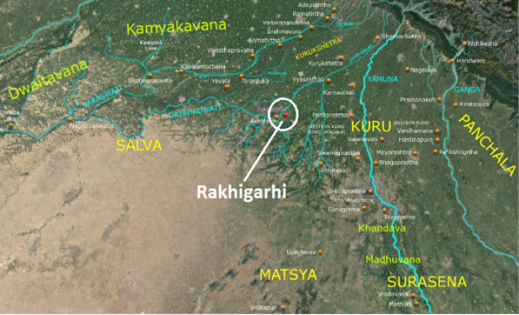
Prof. Vasant Kumar Shinde is affiliated to the Department of Archaeology, Deccan College Post-Graduate and Research Institute, Pune. I have listened to Shinde’s paper presentation titled: – “Summary of the Mahabharata and Archaeological Evidence by Dr Gouri Lad” (, Mahabharata Manthan International Conference on July 2017 at New Delhi, ISBN 9789387587595) where he has linked archaeological evidence with data in Mahabharata. He has deep knowledge on the archaeology of Harappan sites. The work done by the team headed by him studying the ancient DNA from Rakhigarhi cemetery cannot be easily dismissed. Niraj Rai is the group head of Ancient DNA Lab, Birbal Sahni Institute of Palaeoscience.
Another important inference arrived at by Shinde-Rai duo is that the genetic continuity from hunter gatherer to modern times is visible in their genetic studies at Rakhigarhi. In other words, the same hunter-gatherer communities developed into agricultural communities and formed the Harappan / Sindhu Sarasvati Civilization (SSC). Thus, the SCC population is indigenous. This research also suggests that there was movement of people from east to west (in contrast to the west to east movement posited by AIT / AMT). Harappan ethnicity is evident in places like Gonur in Turkmenistan and Sahr i Sokhta in Iran. “We also provide an independent line of evidence from genetics to support existing archaeological evidence, to suggest that there was a substantial migration of people from the Harappan civilization into Eastern Iran and Central Asia”- said Niraj Rai. He also added that “Neolithic began independently in South Asia without any input from the Fertile Crescent by a people distantly related to Iranian Neolithic farmers” and that “Harappan Civilization was a more powerful civilization than was previously admitted in the academia, considering that we found influence from the Sindhu-Sarasvati Culture area to the Jiroft Culture of Iran and to the Oxus Civilization of Central Asia than other way around”. This is a clear indication to Out of India population migration.
“Indus Valley Civilization is largest source of ancestry for South Asians” said David Reich, and hinted that their finding has an indirect impact on the prevailing linguistic theories as it upsets AIT / AMT and favors OIT, viz. migration of IE languages from India to outside, especially to the west.
We must also keep in account that, the Harappans traded with Persia, Sumeria, Akkadia, Arabia and Egypt as revealed in the studies of researchers like Dr S Kalyanaraman (Director of Sarasvati Research Center) and others. Shinde concludes that this resulted in movement of people and mixture of genes and ethnicities. Thus, SSC ethnicity is not only indigenous but also heterogenous and multi ethnic due to the mixture of trading communities.
“As the Harappans traded with Mesopotamia, Egypt, the Persian Gulf and almost all across South Asia, there was bound to be movement of people resulting in a mixed genetic history. India had a heterogeneous population right from the beginning of settled life,” – said Prof. Shinde.
Here I must note that, I have a similar conclusion in my paper (Jijith, Indraprastha Revisited, Yamuna: A Study of Its Links from the Sarasvati Findings” 2016, New Delhi, ISBN 9789386223678) as: – “SSC was composed of Naga-Puru-Yadu ethnicity”. Here the Vedic culture is represented by the ‘Puru’ ethnicity.
Shinde and Rai also makes it very clear that no Anatolian farmer ancestry is found in SSC unlike happened in Europe, where Anatolian farmer migration to Europe led to the spread of agriculture in Europe, transforming its hunter-gatherer population. Shinde’s study in contrast tells us that Iranian related ancestry (consisting of both hunter-gatherers and farmers) found in Bharatavarsha (South Asia), is from a time before the Indo-Iranian genetic split that happened in around 7000 BCE (9000 year ago). Thus, it happened much before a well-argued Rgvedic composition date (by Shrikant Talageri) falling between 4000 BCE to 2000 BCE based on his Out of India Theory (OIT), and of course, well before the AIT/AMT date of 1500 BCE for the Rgvedic composition. Since such a mixing happened 3000 years before the Rgvedic composition it is immaterial if Iranian came to India or vice versa, because they have already become indigenous by the time Rgveda is composed in 3000 years. Nevertheless, it is proven by Srikant Talageri using IE linguistics and now by the work of Shinde and Rai using genetics, that the flow was from India to Iran and never the other way around.
If we want to make sense of this, we need to understand researcher Srikant Talageri’s excellent research work where he has developed a strong Out of India (OIT) theory for the Indo-European Languages. Even though genes don’t carry human spoken languages, genetic migration theories have a collateral impact on language migration theories, because people carrying the genes also carry the spoken languages with them, to one region of origin to other regions.
Srhikant Talageri has authored four books on this topic. The first three books are centered on Indo European (IE) linguistics while the fourth book is centered around the confusion debate on the ancient DNA studies which many AMT theorists think as supporting their theory.
In his first book AIT a Reappraisal (1993) he studies all the major IE languages and shows that Samskrt language has the maximum number of common noun connections with each distinct IE language than any other IE language like Avestan, Greek, Latin or Germanic, proposing that the homeland of IE language thus has to be India with Samskrt being the language closest to the PIE (Proto Indo European Language).
In his second book Rigveda: A Historical Analysis (2000) Talageri analyzes all the ten Mandalas of Rgveda and shows how the events mentioned in Rgveda, the migration of the ethnicities mentioned in it (Yadu, Turvasa, Anu, Drahyu, Puru and Ikshwakus) indicates IE origin in the Sarasvati-Yamuna region (where lies Rakhigarhi). Itihasa Puranas give great importance and holiness to this region, calling it Kurukshetra and Brahmavarta, hailing it as the sacrificial altar of the creator Brahma (probably indicating the great creativity of the Harappan people). I have discussed this region which falls in the Kuru janapatha or Kuru-Rashtra, in great detail in my published research papers. As per Talageri’s analysis the Purus controlled the region between Ganga in the east and Sindhu in the west. They are the originators of the Vedic civilization. The Yadus and Ikshwakus lived in harmony with the Purus but spread southwards and eastwards respectively where they established themselves and propagated the Vedic culture of the Purus with their own innovations and variations into it. The Anus and Drahyus migrated westward from their Indian homeland (Yamuna-Sarasvati region) due to conflicts with the Purus (conflicts are described in Rgveda as Dasarjnya battle – the battle of the ten kings and also in the Itihasa-Puranas as the Deva-Asura wars). The Anus settled in Iran and their language came to be known as Avestan (Indo-Iranian) and later diverged into Persian and other Iranian languages. The Drahyus migrated further west and their language gave rise to the IE languages spoken in Europe like Lituanian, Armenian, Greek, Germanic etc. In this book Talageri established the true relative chronology of the Rgvedic Mandalas, showing that the 1st and 10th Mandalas are younger and the Rshi-family books like the 6th Mandala are much older. This corrects the erroneous chronology of RgVeda proposed by Michel Witzel.
In his third book Rigveda and Avesta: The final evidence (2008), Talegeri expands his OIT thesis, he analyses the Mitanni civilization (which is dated to 1500 BCE to 1300 BCE based on solid archeological evidences). He studied the theonyms found in the Mitanni references and the names of Mitanni heroes and noticed that such names are synchronous with the names found in the younger Mandalas of Rgveda. This enabled him to reject the AIT/ AMT notion that Rgveda is composed in 1500 BCE. The west to east migration hinted in Rgveda combined with the fact that Mitanni vocabulary is identifiable only with the youngest parts of Rgveda, indicates that Mitannis are a branch of Vedic people migrated from the Rgvedic heartland (Yamuna-Sarasvati region, where lies Rakhigarhi). In this book Talageri also analysis the Avestan language (with its texts like Vendidad) and correlate evolution of Avestan texts with the later parts of Rgveda using common theonyms and closely related Avestan and Samskrta terms. He proves without doubt that the Avestan composers are thus the Anus who separated from the Puru cousins who composed the Vedas. Based on the Mitanni evidence and the evidence from Avesta he emerges an absolute chronology for the composition of Rgveda which places its composition between 4000 BCE to 2000 BCE. With this he rubbishes the AIT / AMT date of arrival of ‘Aryans’ into India at 1500 BCE after which, in a hurry, they composed all of the Vedas in a mere 500 years (which makes no sense at all!)
In his fourth book titled – “Genetics and the Aryan debate: ‘Early Indians’ Tony Joseph’s Latest Assault” (2019), Talageri focuses on the recent attempts of the newly entered AIT/AMT advocates like Tony Joseph. Tony argued in his book that Harappans were a mixture of two ancestries: – the Zagros Agriculturists viz. the Anatolian farmers from Iran and the indigenous ‘First Indians’ the Onge people. As per him these foreign farmers came in around 6000 BCE while the natives wre in India since around 60000 years. Talegeri criticizes the attempt of genome-based AMT enthusiasts to ignore the linguistic, archeological, literary and inscriptional evidences against AIT/AMT theory all the while reinforcing his OIT theory, which cries aloud that India is original homeland of IE languages. He criticizes the urge to make premature pro AMT conclusions using the sparse genome research data, often containing no ancient DNA from North West India at all. He focuses his criticism on Tony Joseph’s book titles ‘Early Indians’ (2018) which is nothing but such an attempt. Nevertheless, as predicted by Talageri in his book rebutting Tony’s work, the genetic evidence from Shinde and Rai has now refuted Tony’s line of arguments based on ‘foreign farmers’.
The combined reading of Shinde-Rai duo’s research works and Srikant Talageri’s OIT thesis along with some of my published papers on the geographical data primarily in the Mahabharata gives us a very clear conclusion that 1. Sindhu Sarasvati Civilization (also known as the Harappan civilization) is indigenous, 2. that it is multi-ethnic due to blending of adjacent trading communities 3. that there was no native hunter gatherer replacement by foreign farmers in India (in contrast to what happened in Europe), 4. That the farming civilization of SSC evolved directly from the native hunter-gatherers and 5. There is absolute cultural continuity from the Sindhu Sarasvati Civilization (also known as Indus Valley Civilization) to the Vedic, Aitihasic, Pauranic and modern culture of Bharatavarsha.
The dates for the composition of Rgveda (4000 BCE to 2000 BCE) proposed by Talageri in his book make the Vedic civilization self-same as the SSC civilization, as both of them share same geography and temporal span. My studies reveal that while Rgveda shows the Bharatas as contemporary to its composers like Vasistha, Mahabharata shows the Kurus descended from the Bharatas as contemporary to its composer Vyasa (who was Vasistha’s the great grandson: Vasistha – Shatki – Parasara – Vyasa). Apart from this, I align with the date of Kurukshetra War proposed by Dr Ashok Bhatnagar at 1792 BCE and another one by Ramamoorthy at 1506 BCE, both well in sync with the date of RgVeda proposed by Talagery and with the genealogy of Vasistha to Vyasa.
Thus, according to me, there is no longer any confusions like IVC and Vedic civilization being separate entities (they are one and the same). However, they are multi-ethnic (as revealed by Shinde and Rai, and also in my papers on SSC ethnicity) with the Vedic originators (Purus) living along with the Nagas and Yadus (both blended into Vedic culture right from the beginning) in the vast region spanning from Dwaraka in the south (represented by SSC settlements in Gujarat and Maharashtra), Kurukshetra in the north east (where lies SSC sites Rakhigarhi and Bhirrana), Sindhu in the south west (represented by Mohan jo Daro) and Madra-Kekaya-Gandhara-Bahlika in the north west (represented by the SSC sites in north west Pakistan and Afganistan).
References: –
1. Archaeological and anthropological studies on the Harappan cemetery of Rakhigarhi, India
2. An Ancient Harappan Genome Lacks Ancestry from Steppe Pastoralists or Iranian Farmers
3. The Recorded History of the Indo-European Migrations – Part 3 of 4 The Anu Migrations
5. Yamuna: A Study of Its Links from the Sarasvati Findings- III
6. The Geographical Data in the Mahābhārata – 3
Featured image courtesy (right image): The Mysterious India.
Note: Author is a former scientist who worked in ISRO (2001 to 2006) at SDSC-Sriharikota, as part of the Cryogenic team of GSLV. Took part in three GSLV launches, manning the liquid nitrogen Cryo Console of the Second Launch Pad (SLP) at Filling Control Canter and engaged in the GSLV count down process. Also worked briefly as part of the Chandrayan Study phase orbital simulations at VSSC-Trivandrum and got appreciation from Dr APJ Abdul Kalam during his visit at VSSC to meet young scientists. Involved in Mark 3 initial design phase, SRL (space capsule recovery) experiments and RLV (reusable launch vehicle) experiments.
He is currently engaged in the research of the geographical data present in the Mahabharata. In this capacity he has presented many papers in various international conferences. He owns a web-portal named AncientVoice containing 23,700 plus wikified pages on Veda Itihasa Puranas. He is also an artist and has visualized many scenes from the Mahabharata which was exhibited in different conference venues. Currently he is working in a leading software MNC focusing on creative research on Virtual Reality using devices like HoloLens. Combining this expertise with software technology he is engaged in creating Virtual Avataras of Itihasa personalities in Virtual Reality, Augmented Reality, Mixed Reality and Artificial Intelligence.

